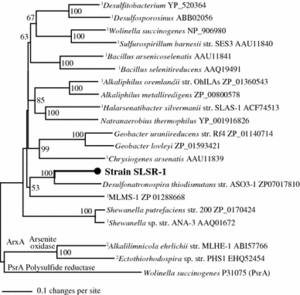Desulfohalophilus alkaliarsenatis: Difference between revisions
| Line 23: | Line 23: | ||
Little is known of the specific genome (i.e circular genome several genes that contribute to the Genes involved in sulfate reduction are (''dsrAB'') and arsenate respiration (''arrA''). Amplicons from 16S rRNA exhibited presence of close relatives of strain SLSR-1 as part of the flora of this ecosystem despite the fact that sulfate-reduction activity could not be detected in situ. Genetically, ''D. alkaliarsenatis'' is related closest to 3 other species of the ''Desulfonatronospira'' family: ''D.spira thiodismutans'' (95 %), ''D.spira delicata'' (94 %) and ''D.spira dismutans'' (94 %). The SLSR-1 partial ArrA was most similar to an ArrA-like encoding gene found in the genome of Desulfonatronospira thiodismutans (71 and 82 % amino acid identity and similarity, respectively) | Little is known of the specific genome (i.e circular genome several genes that contribute to the Genes involved in sulfate reduction are (''dsrAB'') and arsenate respiration (''arrA''). Amplicons from 16S rRNA exhibited presence of close relatives of strain SLSR-1 as part of the flora of this ecosystem despite the fact that sulfate-reduction activity could not be detected in situ. Genetically, ''D. alkaliarsenatis'' is related closest to 3 other species of the ''Desulfonatronospira'' family: ''D.spira thiodismutans'' (95 %), ''D.spira delicata'' (94 %) and ''D.spira dismutans'' (94 %). The SLSR-1 partial ArrA was most similar to an ArrA-like encoding gene found in the genome of Desulfonatronospira thiodismutans (71 and 82 % amino acid identity and similarity, respectively) | ||
[[File:ArrA Phylogeny.gif |right|thumbnail|alt=A large clock tower and other buildings line a great river.|This is the [[Palace of Westminster]] in London]] | |||
==Cell Structure, Metabolism and Life Cycle== | ==Cell Structure, Metabolism and Life Cycle== | ||
Revision as of 22:27, 21 April 2013
Classification
Domain; Phylum; Class; Order; family [Others may be used. Use NCBI link to find]
Species
|
NCBI: Taxonomy |
Genus species
Description and Significance
D. alkaliarsenatis is best described as an anaerobic, haloalkaliphilic bacteria. The SLSR-1 strain morphology is a motile vibrio that stain Gram-negative. The size of the bacteria is roughly .5 x 3.0μm, while TEM revealed the motility was due in part of a 10 μm polar flagellum. The preferred habitat of D. alkaliarsenatis is located in Searles Lake in CA, USA due in part to the high salt content and basic pH. It has demonstrated growth capability via sulfate-reduction over a broad range of salinities (50-300g/L). Most notably it is capable of growth via dissimilatory arsenate reduction which can make it of potential importance in that arsenate can inhibit the conversion of pyruvate into acetyl-CoA, blocking the Krebs cycle and therefore resulting in loss of ATP. Searles Lake is the optimum habitat because of the high arsenate.
Genome Structure
Describe the size and content of the genome. How many chromosomes? Circular or linear? Other interesting features? What is known about its sequence?
Little is known of the specific genome (i.e circular genome several genes that contribute to the Genes involved in sulfate reduction are (dsrAB) and arsenate respiration (arrA). Amplicons from 16S rRNA exhibited presence of close relatives of strain SLSR-1 as part of the flora of this ecosystem despite the fact that sulfate-reduction activity could not be detected in situ. Genetically, D. alkaliarsenatis is related closest to 3 other species of the Desulfonatronospira family: D.spira thiodismutans (95 %), D.spira delicata (94 %) and D.spira dismutans (94 %). The SLSR-1 partial ArrA was most similar to an ArrA-like encoding gene found in the genome of Desulfonatronospira thiodismutans (71 and 82 % amino acid identity and similarity, respectively)

Cell Structure, Metabolism and Life Cycle
Interesting features of cell structure; how it gains energy; what important molecules it produces.
Ecology and Pathogenesis
Habitat; symbiosis; biogeochemical significance; contributions to environment.
If relevant, how does this organism cause disease? Human, animal, plant hosts? Virulence factors, as well as patient symptoms.
References
Author
Page authored by _____, student of Prof. Jay Lennon at Michigan State University.
<-- Do not remove this line-->

